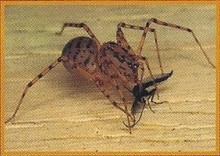Like a baseball player or rodeo rider, this spider is an expert spitter. The arachnid likes to stalk victims, then spits at prey, using streams of glue-like venom to trap them in place. With the victim stuck, the spider then closes in. The helpless victim can only squirm as the spider delivers a fatal bite with its short fangs.
Daddy Long Legs: The spitting spider's eight legs are long and thin compared to its bulbous body. The creature's steps are almost silent as it stalks its prey.
Prey Tell: This little spider has hundreds of tiny hairs on its legs that make up a complex "radar" system. These hairs are ultra-sensitive to air, and can even feel the vibrations in the air made by the twitching of an insect's wings; this lets the spider know that potential prey is near.
Stuck for Life[]

The spider "ties" flies to the ground.
The spitting spider comes out to hunt at night, but this stalker never chases prey. When the spider's sensory hairs detect a nearby victim, the hunter moves in slowly and silently until it's less than half an inch away. Then, within a fraction of a second, the spider spits twin jets of fluid from its fangs; the goo hardens on contact and glues the victim to the ground. The spitting spider then makes the kill by injecting the victim with venom, which liquifies its body.
Chopper: Large insects can put up a fight when the spitting spider moves in to bite, even when pinned to the ground. If an ensnared victim still struggles, the spider uses its fangs to snip off the prey's legs.
House Hunter: This spider originally came from the tropics of Asia, but it has been introduced to all continents but Antarctica. In populated areas, the spitting spider makes its home in the dark, damp corners inside people's homes.
Sticky Stuff[]
- Noticing a fly on a nearby branch, the spitting spider begins the slow crawl toward its prey, using tiny claws on the ends of each long leg to step gently over the leaves, clinging to each one but not making a sound. The fly is unaware of the spider's approach.
- Sneaking up slowly, the spider finally comes within range of the fly. The spider lifts its head and shoots its sticky "web" at the fly, gluing it in place in an instant. The substance is laced with the spider's toxins, which begin to kill the fly even before the spider bites.
